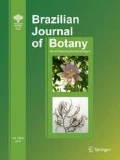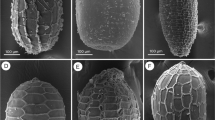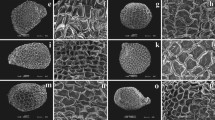Abstract
Euphorbia L., with around 2000 species, is the biggest genus of Euphorbiaceae and one of the largest and most diverse genera within Angiosperms. It shows an almost cosmopolitan distribution and notable morphological diversity and is characterized by a pseudanthial inflorescence, the cyathium, which is unique to the genus. Along with its great morphological diversity in growth form, seed characters such as shape, testa ornamentation and presence or absence of caruncle are among its most notable and variable features. Given the potential utility of seed characters for species identification, we set to characterize the seeds from all known species (24) of Euphorbia occurring in the state of São Paulo, using photos and scanning electronic microscopy images. These species belong to three subgenera and seven sections of Euphorbia, and their morphological diversity is discussed in a phylogenetic context according to the most recent classification. Seed characters such as shape, size, testa ornamentation, and presence or absence of caruncle proved to be useful for identification of sections and for distinguishing closely related species.





Similar content being viewed by others
References
Boissier E (1862) Euphorbieae. In: Candolle ALPP (ed) Prodromus Systematics Universalis Regni Vegetabilis 15(2). Victor Masson, Paris, pp 3–188
Bruyns PV, Mapaya RJ, Hedderson T (2006) A new subgeneric classification for Euphorbia (Euphorbiaceae) in Southern Africa based on ITS and psbA-trnH sequence data. Taxon 55:397–420
Can L, Küçüker O (2015) Seed morphology and surface microstructure of some Euphorbia (Euphorbiaceae) taxa distributed in Turkey-in-Europe. Turk J Bot 39:449–457
Dorsey BL, Haevermans T, Aubriot X, Morawetz JJ, Riina R, Steinmann VW, Berry PE (2013) Phylogenetics, morphological evolution, and classification of Euphorbia subgenus Euphorbia. Taxon 62:291–315
Frodin DG (2004) History and concepts of big plant genera. Taxon 53:753–776
Govaerts R, Frodin DG, Radcliffe-Smith A (2000) World checklist and bibliography of Euphorbiaceae (and Pandaceae), vol. 2. Royal Botanical Gardens, Kew
Hafford DA, Harris WK (2012) A taxonomic revision of Euphorbia section Anisophyllym Roeper (Euphorbiaceae) in Australia. Austrobaileya 8:441–600
Harris JG, Harris MW (2001) Plant identification terminology: an illustrated glossary. Spring Lake Publishing, Payson
Horn JW, Van Ee BW, Morawetz JJ, Riina R, Steinmann VW, Berry PE, Wurdack KJ (2012) Phylogenetics and the evolution of major structural characters in the giant genus Euphorbia L. (Euphorbiaceae). Mol Phylogenet Evol 63:305–326
Morawets JJ, Riina R, Berry PE, Mayfield MH (2009) Euphorbia seed atlas part 1. Euphorbia World 5:27–29
Morawetz JJ, Riina R, Berry PE, Mayfield MH (2010a) Euphorbia seed atlas part 2. Euphorbia World 6:25
Morawetz JJ, Riina R, Berry PE, Mayfield MH (2010b) Euphorbia seed atlas part 4. Euphorbia World 6:21
Müller Argoviensis J (1874) Euphorbiaceae. In: Martius CFP, Eichler AW (eds) Flora Brasiliensis 11(2). Frid. Fleischer, München, pp 1–752
Pahlevani AH, Akhani H (2011) Seed morphology of Iranian annual species of Euphorbia (Euphorbiaceae). Bot J Linn Soc 167:212–234
Pahlevani AH, Liede-Schumann S, Akhani H (2015) Seed and capsule morphology of Iranian perennial species of Euphorbia (Euphorbiaceae) and its phylogenetic application. Bot J Linn Soc 177:335–377
Peirson JA, Bruyns PV, Riina R, Morawetz JJ, Berry PE (2013) A molecular phylogeny and classification of the largely succulent and mainly African Euphorbia subg. Athymalus (Euphorbiaceae). Taxon 62:1178–1199
Radcliffe-Smith A (2001) Genera Euphorbiacearum. Kew Publishing, Kew
Riina R, Peirson JA, Geltman DV, Molero J, Frajman B, Pahlevani A, Barres L, Morawetz JJ, Salmaki Y, Zarre S, Kryukov A, Bruyns PV, Berry PE (2013) A worldwide molecular phylogeny and classification of the leafy spurges, Euphorbia subgenus Esula (Euphorbiaceae). Taxon 62:316–342
Salmaki Y, Zarre S, Esser H-J, Heubl G (2011) Seed and gland morphology in Euphorbia (Euphorbiaceae) with focus on their systematic and phylogenetic importance, a case study in Iranian highlands. Flora 206:957–973
Silva OLM, Cordeiro I, Caruzo MBR (2014) Synopsis of Euphorbia (Euphorbiaceae) in the state of São Paulo, Brazil. Phytotaxa 181:193–215
Steinmann VW (2013) Three new species of Euphorbia subg. Chamaesyce (Euphorbiaceae) from Bolivia. Phytotaxa 114:23–32
Steinmann VW, Porter JM (2002) Phylogenetic relationships in Euphorbieae (Euphorbiaceae) based on ITS and ndhF sequence data. Ann Missouri Bot Gard 89:453–490
Steinmann VW, Caruzo MBR, Silva OLM (2015) Euphorbia In: Lista de Espécies da Flora do Brasil. Jardim Botânico do Rio de Janeiro. http://floradobrasil.jbrj.gov.br/jabot/floradobrasil/FB17561. Accessed 15 May 2015
Thiers B (2015) Index Herbariorum: a global directory of public herbaria and associated staff. New York Botanical Garden’s Virtual Herbarium. The New York Botanical Garden. http://sciweb.nybg.org/science2/IndexHerbariorum.asp. Accessed 15 May 2015
Wagner B, Morawetz JJ, Riina R, Berry PE, Becker R, Moller A (2010) Euphorbia seed atlas—part 3. Euphorbia World 6:28–29
Wagner B, Morawetz JJ, Riina R, Berry PE, Becker R, Moller A (2011a) Euphorbia seed atlas—part 5. Euphorbia World 7:11
Wagner B, Morawetz JJ, Riina R, Berry PE, Becker R, Moller A (2011b) Euphorbia seed atlas—part 6. Euphorbia World 7:21
Wagner B, Morawetz JJ, Riina R, Berry PE, Becker R, Moller A (2011c) Euphorbia seed atlas—part 7. Euphorbia World 7:15
Yang Y, Riina R, Morawetz JJ, Haevermans T, Aubriot X, Berry PE (2012) Molecular phylogenetics and classification of Euphorbia subgenus Chamaesyce (Euphorbiaceae). Taxon 61:764–789
Zimmermann NFA, Ritz CM, Hellwig FH (2010) Further support for the phylogenetic relationships within Euphorbia L. (Euphorbiaceae) from nrITS and trnL-trnF IGS sequence data. Plant Syst Evol 286:39–58
Zorić L, Merkulov L, Luković J, Boža P (2010) Comparative seed morphology of Trifolium L. species (Fabaceae). Period Biol 112:263–272
Acknowledgments
We thank Coordenação de Aperfeiçoamento de Pessoal de Nível Superior (CAPES) for the scholarship provided to the first author. We are also grateful to Marília Duarte for the discussion on terminology, to Luciana Benatti for the support on producing the SEM images and to the three anonymous reviewers.
Author information
Authors and Affiliations
Corresponding author
Rights and permissions
About this article
Cite this article
da Silva, O.L.M., Cordeiro, I. & Caruzo, M.B.R. Seed morphology in Euphorbia and its taxonomic applications: a case study in São Paulo, Brazil. Braz. J. Bot 39, 349–358 (2016). https://doi.org/10.1007/s40415-015-0228-9
Received:
Accepted:
Published:
Issue Date:
DOI: https://doi.org/10.1007/s40415-015-0228-9




